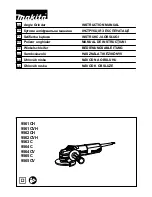
the ball-link and clevise from turning. Supplied in the kit is plastic linkage fairing, pre-painted to
match the fin colour, which can be glued in place to cover the linkage (see photo page 23).
IMPORTANT NOTE:
As the pin in the clevise is made from aluminium, and it fits tightly into
the hole in the aluminum servo arm it is imperative that you apply a little grease or light oil to
this joint too make sure that it can swivel smoothly and cannot stick together.
Fit the socket of your extension lead from the receiver into
a small piece of phenolic or plywood and glue into a slot in
the top of the fuselage under the Fin root, to connect the
servo lead into (right). We highly recommend that you pro-
tect the servo extension lead inside the fuselage with alu-
minium tape, or equivalent, and check it regularly - as it is
directly above the exhaust ducting and could be damaged
if you have any accidental wet-starts or similar. You should
add a small plate of 3mm balsa underneath the socket in
the fuselage, and cover this with aluminium tape, as well as
the extension lead where it is routed to the the side of the
fuselage. (see photo P47)
Fuel System
Main tanks
Included in the kit are a pair of ‘kidney-shaped’ composite-kevlar moulded ‘baffled’ fuel tanks
(capacity 2.9 litres each) which have already been joined, fitted with the aluminium sleeves for
the cap, checked for integrity and fitted into your fuselage. They are held in position by the spar
tube, which makes removal for maintenance simple and quick, but when you remove this tube
for transport you can fit a shorter piece of tube (about 350mm long) temporarily to keep the tanks
in position. The angled fuel stopper positions allow you to carry out all normal maintenance of
the tanks without removing them from the fuselage. All necessary hardware to complete the fuel
system is included in the kit (kerosene stoppers, aluminium caps, clunks, tees, brass tube and
clear fuel tubing).
Use the supplied lengths of 4mm brass tubing in the aluminium caps and the kerosene stoppers,
which are all included. Because the main tanks have a baffle in the middle you need to make the
tube inside the tank to the clunk weight from 2 shorter pieces of the flexible tube, with a length
of brass tube in the centre where it passes through the baffle. If you don’t do this the edges of
the hole in the fibreglass baffle will cut thru’ the flexible tubing in just 1 or 2 flights.... (photo P41).
The fuel tube supplied is 4mm I.D. and therefore you must definitely add fuel ‘barbs’ to all the
brass tubes to prevent air being sucked into the fuel system. Provided in the hardware are 10
very short lengths of 4mm I.D brass tube which should be soft-soldered over all the 4mm O.D
brass tubes where the fuel tube will be connected, about 10 -12mm from the ends. Clean both
parts first with ‘Scotchbrite’ or fine sandpaper for good joints (see photo P42).
You can either use heavy clunks in the main tanks, or you can use 2 of the felt clunks provided
in the hardware
with the felt removed
. The extra drag of 3 felt clunks on the fuel system can
cause high fuel pump voltages, and in extreme cases insufficient flow to your turbine.
When you finally install the fuel tanks they should not be a loose fit inside the fuselage, and you
can add small foam pads to hold them firmly in position if necessary.
24
(above) Glue the rudder exten-
sion lead socket into a small ply or
phenolic plate on the fuselage.















































